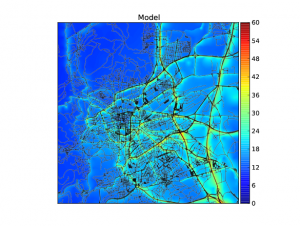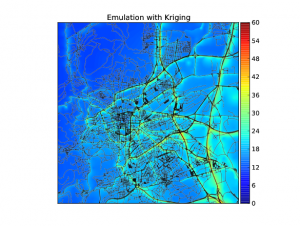Objective
An urban air quality model is so computationally intensive that propagating uncertainties inside such a model is a challenging task. Our strategy is to generate a meta-model which essentially reproduces the results of the original model at very low cost.
Meta-modeling of ADMS Urban
We made use of the urban air quality model ADSM Urban, applied to the city of Clermont-Ferrand. First, we carried out dimension reduction, and then designed a statistical emulator of the resulting reduced model. Such model was constructed for NO2 and PM10. Below is one comparison of computed PM10 maps, with the original model (left) and with the meta-model (right).
When compared to the observations, the meta-model shows similar performance as the original model, which tends to show that the most important features are retained in the meta-model.
While the original model requires several minutes to compute one air pollution map, the meta-model requires between 50 ms and 150 ms. Therefore, it opens the way to complex uncertainty quantification methods.
Reference
Reduction and Emulation of ADMS Urban. V. Mallet, A. Tilloy, D. Poulet, S. Girard, F. Brocheton. To be submitted.



